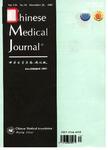Interventional Bronchoscopic Therapy in Adult Patients with Tracheobronchial Mucoepidermoid Carcinoma
Interventional Bronchoscopic Therapy in Adult Patients with Tracheobronchial Mucoepidermoid Carcinoma作者机构:Department of Pulmonary Diseases Beijing Tian Tan Hospital Capital Medical University Beijing 100050 China
出 版 物:《Chinese Medical Journal》 (中华医学杂志(英文版))
年 卷 期:2017年第130卷第20期
页 面:2453-2458页
核心收录:
学科分类:090603[农学-临床兽医学] 1002[医学-临床医学] 08[工学] 09[农学] 0906[农学-兽医学] 0901[农学-作物学] 0836[工学-生物工程] 090102[农学-作物遗传育种]
基 金:Capital Medical University
主 题:Adult Bronchoscopy Bronchus Mucoepidermoid Carcinoma
摘 要:Background: Tracheobronchial mucoepidermoid carcinoma (MEC) is a rare airway tumor in adults for which surgery is considered a first-line treatment. However, some patients already lost the best opportunity of a surgical intervention when diagnoses are confirmed, and surgery causes considerable trauma resulting in partial loss of pulmonary function. Moreover, the tumor is resistant to radiotherapy and chemotherapy. These factors make the treatment of tracheobronchial MEC challenging. This study aimed to evaluate the safety and et^cacy ofinterventional bronchoscopic therapy in adult patients with tracheobronchial MEC. Methods: We retrospectively analyzed the clinical manifestations, bronchoscopic interventions, complications, and outcomes of 11 adult patients with tracheobronchial MEC. Paired t-test was used to analyze the parameters of the American Thoracic Society Dyspnea Index and the Karnofsky Score before and after the first interventional bronchoscopic therapy. Results: All tumors occurred in the main bronchus and were easily visualized by bronchoscopy. After interventional bronchoscopic therapy, the symptoms of all patients showed significant improvement. The American Thoracic Society Dyspnea Index decreased from 1.91 ± 1.22 to 0.27 ± 0.47 (t = 6.708, P 〈 0.001) and the Kamofsky Score increased from 78.18 ±16.62 to 95.46 ± 8.20 (t =-5.190, P 〈 0.001 ). Bronchoscopic intervention did not result in serious complications or mortality. During the follow-up period between 3 and 96 months after the first therapy, the following results were noted: ( 1 ) among the eight patients with low-grade tracheobronchial MEC, only one patient had a relapse and agreed to surgical treatment; (2) among the three patients with high-grade tracheobronchial MEC, one patient required repeated bronchoscopic interventions, one patient died of pulmonary infection, and one patient died of systemic failure owing to tumor metastasis. Conclusions: Interventional bronchoscopic therapy, as an alt



